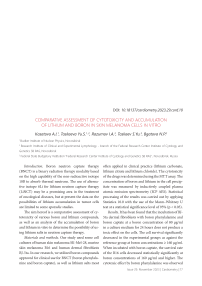Comparative assessment of cytotoxicity and accumulation of lithium and boron in skin melanoma cells in vitro
Автор: Kasatova A.I., Taskaeva Yu.S., Razumov I.A., Taskaev S.Yu., Bgatova N.P.
Журнал: Cardiometry @cardiometry
Рубрика: Conference proceedings
Статья в выпуске: 29, 2023 года.
Бесплатный доступ
Boron neutron capture therapy (BNCT) is a binary radiation therapy modality based on the high capability of the non-radioactive isotope 10B to absorb thermal neutrons. The use of alternative isotope 6Li for lithium neutron capture therapy (LiNCT) may be a promising area in the treatment of oncological diseases, but at present the data on the possibilities of lithium accumulation in tumor cells are limited to some sporadic studies.
Neutron capture therapy, boron-containing compounds, lithium salts, skin melanoma
Короткий адрес: https://sciup.org/148327382
IDR: 148327382 | DOI: 10.18137/cardiometry.2023.29.conf.10
Текст статьи Comparative assessment of cytotoxicity and accumulation of lithium and boron in skin melanoma cells in vitro
-
1 Budker Institute of Nuclear Physics, Novosibirsk
-
2 Research Institute of Clinical and Experimental Lymphology - branch of the Federal Research Center Institute of Cytology and Genetics SB RAS, Novosibirsk
-
3 Federal State Budgetary Institution "Federal Research Center Institute of Cytology and Genetics SB RAS", Novosibirsk, Russia
Introduction . Boron neutron capture therapy (BNCT) is a binary radiation therapy modality based on the high capability of the non-radioactive isotope 10B to absorb thermal neutrons. The use of alternative isotope 6Li for lithium neutron capture therapy (LiNCT) may be a promising area in the treatment of oncological diseases, but at present the data on the possibilities of lithium accumulation in tumor cells are limited to some sporadic studies.
The aim hereof is a comparative assessment of cytotoxicity of various boron and lithium compounds, as well as an analysis of the accumulation of boron and lithium in vitro to determine the possibility of using lithium salts in neutron capture therapy.
Materials and methods. Our study used some cell cultures of human skin melanoma SK-Mel-28, murine skin melanoma B16 and human dermal fibroblasts BJ-5ta. In our research, we utilized boron compounds approved for clinical use for BNCT (boron phenylalanine and boron captate), as well as lithium salts most often applied in clinical practice (lithium carbonate, lithium citrate and lithium chloride). The cytotoxicity of the drugs was determined using the MTT assay. The concentration of boron and lithium in the cell precipitate was measured by inductively coupled plasma atomic emission spectrometry (ICP AES). Statistical processing of the results was carried out by applying Statistica 10.0 with the use of the Mann–Whitney U test at a statistical significance level of 95% (p < 0.05).
Results . It has been found that the incubation of BJ-5ta dermal fibroblasts with boron phenylalanine and boron captate at a boron concentration of 80 μg/ml in a culture medium for 24 hours does not produce a toxic effect on the cells. The cell survival significantly decreased in the experimental groups as against the reference group at boron concentrations ≥ 160 μg/ml. When incubated with boron captate, the survival rate of the B16 cells decreased statistically significantly at boron concentrations of 160 μg/ml and higher. The cytotoxic effect by boron phenylalanine was observed
Issue 29. November 2023 | Cardiometry | 17
at boron concentrations ≥ 320 μg/ml. Cytotoxicity of boron compounds during the incubation with the SK-Mel-28 cells was noted at medium-related boron concentrations ≥ 640 μg/ml. When the BJ-5ta cells were incubated with three test lithium salts at a lithium concentration of 80 μg/ml (necessary, according to theoretical calculations, for successful neutron capture therapy), no toxic effect was detected. A lithium concentration of 160 μg/ml under the incubation of the BJ-5ta cells with every of the three lithium salts was found to be toxic. Lithium carbonate had no toxic effect on the SK-Mel-28 and B16 melanoma cells in the lithium concentration range up to 160 μg/ml. Lithium citrate also did not make a toxic effect on the B16 cells at a lithium concentration of 160 μg/ml, but however, for the SK-Mel-28 culture, a concentration of 160 μg/ml or greater statistically significantly reduced the percentage of the cell survival compared to the reference group. The survival of the B16 cells when exposed to lithium chloride at lithium concentrations up to 320 μg/ml did not differ significantly from the reference, but for the SK-Mel-28 cells the cytotoxic effect was revealed at lithium concentrations ≥ 160 μg/ml.
The maximum boron concentration was determined, when the SK-Mel-28 and B16 cells were incubated with boron phenylalanine, and it was 0.29 μg/106 cells; Moreover, the highest concentration of lithium was detected during incubation of the B16 culture with lithium carbonate and amounted to 0.79 μg/106 cells.
Conclusion . Lithium salts, as well as boron compounds, do not significantly reduce the survival of tumor cells and normal fibroblasts at concentrations of 40-80 μg/ml required for neutron capture therapy. Lithium carbonate is most effectively accumulated by tumor cells, compared to other lithium salts and boron compounds, and can be used as a drug for delivering lithium to a tumor for NCT.


